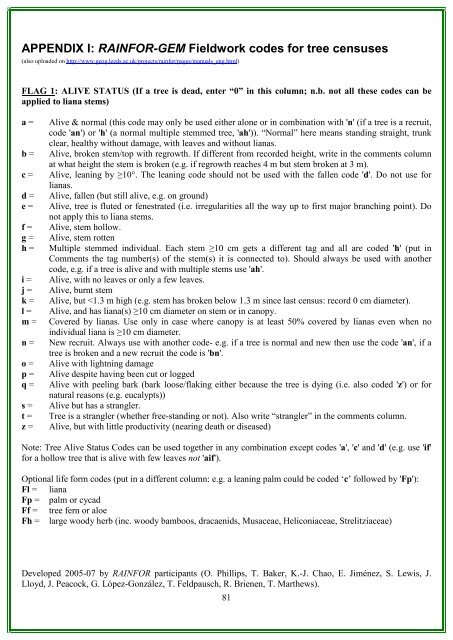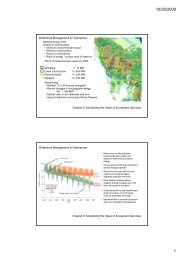RAINFOR GEM Intensive Plots Manual (pdf) - University of Oxford
RAINFOR GEM Intensive Plots Manual (pdf) - University of Oxford
RAINFOR GEM Intensive Plots Manual (pdf) - University of Oxford
- No tags were found...
You also want an ePaper? Increase the reach of your titles
YUMPU automatically turns print PDFs into web optimized ePapers that Google loves.
APPENDIX I: <strong>RAINFOR</strong>-<strong>GEM</strong> Fieldwork codes for tree censuses(also uploaded on http://www.geog.leeds.ac.uk/projects/rainfor/pages/manuals_eng.html)FLAG 1: ALIVE STATUS (If a tree is dead, enter “0” in this column; n.b. not all these codes can beapplied to liana stems)a =b =c =d =e =f =g =h =i =j =k =l =m =n =o =p =q =s =t =z =Alive & normal (this code may only be used either alone or in combination with 'n' (if a tree is a recruit,code 'an') or 'h' (a normal multiple stemmed tree, 'ah')). “Normal” here means standing straight, trunkclear, healthy without damage, with leaves and without lianas.Alive, broken stem/top with regrowth. If different from recorded height, write in the comments columnat what height the stem is broken (e.g. if regrowth reaches 4 m but stem broken at 3 m).Alive, leaning by ≥10°. The leaning code should not be used with the fallen code 'd'. Do not use forlianas.Alive, fallen (but still alive, e.g. on ground)Alive, tree is fluted or fenestrated (i.e. irregularities all the way up to first major branching point). Donot apply this to liana stems.Alive, stem hollow.Alive, stem rottenMultiple stemmed individual. Each stem ≥10 cm gets a different tag and all are coded 'h' (put inComments the tag number(s) <strong>of</strong> the stem(s) it is connected to). Should always be used with anothercode, e.g. if a tree is alive and with multiple stems use 'ah'.Alive, with no leaves or only a few leaves.Alive, burnt stemAlive, but





